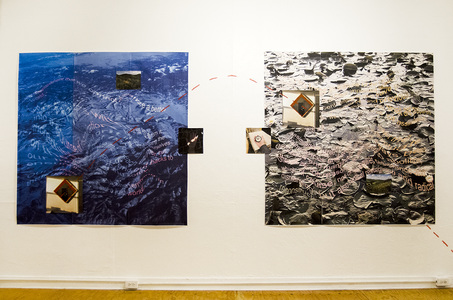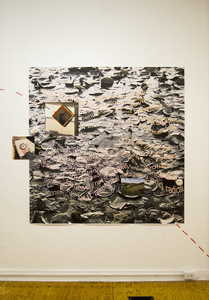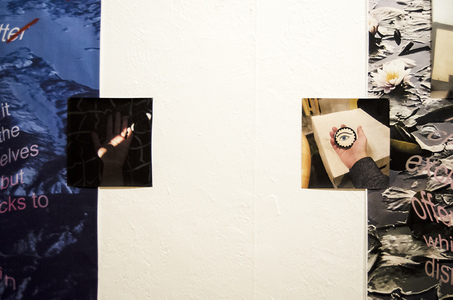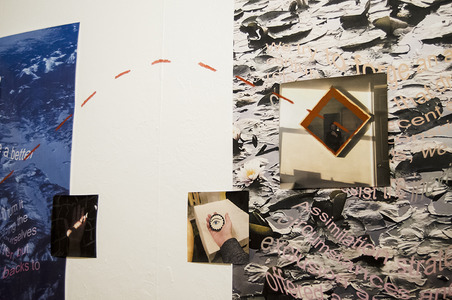The edge of a photograph like the border of our minds, our states, our homes. A reflection, a mirror, with its own borders and a world within it. A dotted line like from a treasure map, leading from out the image, through the image, through the mirror, above the image, across the wall, between the images, above again, within the mirror, reflected. This work is in process, it is a reflection of my experience contextualized amongst new knowledge and emotion; and although this particular physical manifestation is “completed” (that is to say that it is on the wall and has been presented to the public) it will not only eventually be torn off the wall and thrown in the garbage (purposefully made of recyclable, non-permanent materials) it is also a visual representation of the processing of ideas and new perspectives, presented in an image, to process and imprint onto my mind as a sort of turning point, a reference. How do we connect the dots between borders, movements, ideas? How do we practice these things in real time, in what is inevitably an imperfect process, with imperfect results, done by imperfect people? How can we be brave to do, and then learn?
“Disappointment that we cannot actualize a better world…
We must come to terms with this fear and turn it into a source of inspiration by acknowledging the incredible courage and grit it takes to put ourselves on the line. We must trust not just each other, but our inevitable stumbles. We must bend out backs to ensure the fumbling of our ideas land softly.
Our efforts are equally powerful and terrifying in their naive honesty: We want a just world.” - Sandra Marie Nurse, Tidal 2: Occupy Theory, Occupy Strategy September 2012
“I have learned from Cedric Robinson that any theory or political strategy that pretends to possess a total theory of freedom, or one that can be categorically understood, has failed to account for the multiplicity of possibilities, which can, perhaps, only be evocatively represented in the realm of culture.
What this means, I think, is that we try to forge an analysis of the current conjuncture that draws important lessons from the relatively recent campaigns that have pushed our collective consciousness beyond previous limits. In other words, we need movements that are prepared to resist the inevitable seductions of assimilation.
Assimilation strategies that leave intact the circumstances and structures that perpetuate exclusion and marginalization have always been offered as the reasonable alternative to abolition, which, of course, not only requires resistance and dismantling, but also radical reimagining and radical reconstructions.” - Angela Davis in an interview for Literary Hub on Black Lives Matter, Palestine, and the Future of Radicalism, September 2017
I frame this work around desire, around the idea of “feeling the fear and doing it anyway”. The quotes, stated above and abstracted in the installation illustrate both pushing the boundaries of my understanding of my identity and it’s placement within a larger context as well as reflecting on my impact as a person and how we can feel that fear, of the mystery that might surround actualizing a better world, and doing it anyway, because it is necessary. Exposed hands, open to light, warmth, history, and ultimately change; with desire, and beauty, and a better world as the guiding principle; within a particular type of container and political restraints; and the acknowledgement that these are difficult challenges that will push each of our understandings of ourselves and our impacts, abstractly woven into the process itself; for the public to view as a reflective space illustrating the interconnectedness between the many versions of ourselves as well as one another.
“Disappointment that we cannot actualize a better world…
We must come to terms with this fear and turn it into a source of inspiration by acknowledging the incredible courage and grit it takes to put ourselves on the line. We must trust not just each other, but our inevitable stumbles. We must bend out backs to ensure the fumbling of our ideas land softly.
Our efforts are equally powerful and terrifying in their naive honesty: We want a just world.” - Sandra Marie Nurse, Tidal 2: Occupy Theory, Occupy Strategy September 2012
“I have learned from Cedric Robinson that any theory or political strategy that pretends to possess a total theory of freedom, or one that can be categorically understood, has failed to account for the multiplicity of possibilities, which can, perhaps, only be evocatively represented in the realm of culture.
What this means, I think, is that we try to forge an analysis of the current conjuncture that draws important lessons from the relatively recent campaigns that have pushed our collective consciousness beyond previous limits. In other words, we need movements that are prepared to resist the inevitable seductions of assimilation.
Assimilation strategies that leave intact the circumstances and structures that perpetuate exclusion and marginalization have always been offered as the reasonable alternative to abolition, which, of course, not only requires resistance and dismantling, but also radical reimagining and radical reconstructions.” - Angela Davis in an interview for Literary Hub on Black Lives Matter, Palestine, and the Future of Radicalism, September 2017
I frame this work around desire, around the idea of “feeling the fear and doing it anyway”. The quotes, stated above and abstracted in the installation illustrate both pushing the boundaries of my understanding of my identity and it’s placement within a larger context as well as reflecting on my impact as a person and how we can feel that fear, of the mystery that might surround actualizing a better world, and doing it anyway, because it is necessary. Exposed hands, open to light, warmth, history, and ultimately change; with desire, and beauty, and a better world as the guiding principle; within a particular type of container and political restraints; and the acknowledgement that these are difficult challenges that will push each of our understandings of ourselves and our impacts, abstractly woven into the process itself; for the public to view as a reflective space illustrating the interconnectedness between the many versions of ourselves as well as one another.
After Tidal










